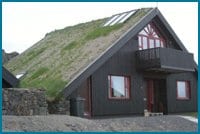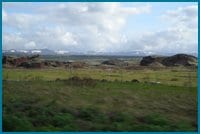
MUD MEN. Modern sod houses like this one keep Iceland's environmental footprint relatively modest. Credit: (Nicholas Little photo)
“Modernity did not develop gradually and unnoticed in Iceland,” writes author Thráinn Bertelsson, “it arrived almost overnight with a crash and a bang.”
Perhaps true, but the crash and bang of nature can silence even modernity in this northern and geothermically active nation. Registering 6.1 on the Richter scale, the earthquake that hit during my visit to Iceland last month brought state and commerce alike to a standstill. The seismic shift was a powerful reminder that the Icelandic people are ambitious, if not reckless, pioneers. Attempting to resist and tame an inhospitable land of fire and ice is not for the faint-hearted.
In his own take on the advent of modernity in Iceland, Halldór Laxness, the only Icelandic writer to receive the Nobel prize for literature, wrote, “We now have in Reykjavík all of a sudden got everything which suits a cosmopolitan city, not only a university and a cinema, but also football and homosexuality.”
So modernity was already making noise in Reykjavík in 1925, when Laxness wrote that, and has been booming onward since, gathering increasing momentum after Iceland’s independence in 1944.
“We do things differently here”
The drive from Keflavík airport toward Reykjavík is a disorienting mix of lunar topography dotted with US army barracks converted into modern condos. Traditional wooden fish-drying frames and geothermal hot pools are followed by Quiznos sandwich shops and the new shopping centre commonly referred to as the “Penis Mall” for its coincidental (or not) shape.
Zipping along with my teenage nephew and my 20-something niece in her brand new Volkswagen Golf, the speakers blaring a Ministry of Sound mix tape while she lists possible clubs to visit that night, it is the same iPod Smirnoff meta-culture you can access in any affluent, global city.
But in the same way that ketchup chips and Clamato juice on the Wal-Mart shelves must mean we’re in Canada, there are threads in the modern Icelandic fabric that anchor the global experience within the local culture. Differences that transcend the corporate, thankfully.
Take, for example, my niece’s Golf. On close inspection, I notice an odd contraption emblazoned with the VW logo in the space between the driver and front passenger seats. Asked what it is, my niece replies, “Bottle opener. So my friends can have fun while I drive them to the party.”
And sure enough, a few hours later we are racing down a volcanic vista highway in the broad midnight sun knocking back Thule lagers while being driven to a party at downtown hotspot Nasa. Iceland’s drinking and driving laws are notoriously strict, but since they’re not driving, passengers are free to drink.
People can also drink outside on the streets. Very popular after the bars close is to stand around in the square downtown and keep drinking. If you are leaving the bar, the bouncers give you a plastic cup to take your drink out with you.
Recently, Reykjavík experimented with having no last-call cut-off, then decided to cap it at 5:30am. Reykjavík Police’s third in command told BBC News that a relaxed approached to last-call is a matter of principle, allowing people more freedom to drink when they want to. Imagine a country where top police brass publicly advocate for people’s freedom to consent to what they want!
That same libertarian attitude carries over to how Icelanders view youth and sexuality. To make room for my visit, my 16-year-old nephew gives up his bed and instead sleeps at his girlfriend’s home nearby. Upon noting that such liberal approaches to parenting are few and far between in Canada, my sister laughs and says, “We do things differently here in Iceland.”
Prolific Iceland
Hit the streets of Reykjavík on any weekend night and you could easily believe you’re in London or Stockholm. The Reykjavík scene is hyper-stylish, expensive and rowdy till all hours. People pour into the streets, cars circle endlessly looking for that last parking spot and teenagers roam in small fashionable gangs. Icelandic men and women dress to impress and have the stunning looks to pull it off.
It’s easy, then, to forget where you actually are: a huge, isolated island with very few people. Iceland has the fifth lowest population density in the world with only 3.0 people per square kilometre (Canada is only slightly more dense at 3.2 people per square kilometre). The total population of Iceland is a mere 316,000, two-thirds of whom live in the Greater Reykjavík area. In his Letters to Iceland, WH Auden wrote, “I like it if only because this nation / Enjoys a scarcity of population.”
Put in this context, Reykjavík’s cosmopolitan credentials are somewhat staggering. The capital city produces two daily newspapers, sustains two national television stations, has a sought-after roster of local fashion designers, fosters bold and forward-thinking architecture and churns out an astonishing number of internationally acclaimed musicians and films. Hell, Reykjavík has even produced two Miss Worlds! And all with only a population the size of Kitchener, Ontario. Canada’s largest metropolis can barely compete, let alone Ontario’s smaller towns.
Yet Reykjavík’s bragging rights simply reflect those of the nation as a whole. In 2007, Iceland was ranked first on the UN’s Human Development Index, which measures quality of life by looking at life expectancy, literacy, educational attainment, and GDP per capita. Canada ranked fourth.
Iceland is one of the world’s most literate societies, with more books published per head than anywhere else. There are no tuition fees at state-run universities and education levels are very high for both sexes. Unemployment is almost non-existent. Firearms are banned from the entire island outside hunting guns. And Icelanders enjoy one of the longest life expectancies in the world.
Iceland is also a leader in gender equality. On October 24, 1975 the country’s economic, cultural and domestic life ground to a halt when 90 percent of Icelandic women took an organized “day off” by refusing to work, cook or look after children. An incredibly effective consciousness raising feat, the day off is remembered as the kick-start of the modern Icelandic feminist movement. In 1980, Vigdis Finnbogadottir became the world’s first democratically elected woman head of state and, a few years later, Icelandic women created the world’s first purely feminist parliamentary party.
Community leaders
Today the social and legal status of gays and lesbians in Iceland is among the most advanced in the world. And while the rapid progress enjoyed by modern Icelandic queers may appear to have come with a crash and a bang, it is in fact due to many decades of work by Icelandic queer communities and their leaders.
This June, Samtökin ‘78, the national queer organization, will celebrate its 30th anniversary. Formed 14 years before discrimination on the grounds of sexual orientation was abolished and at a time when prejudice forced many gays and lesbians to immigrate abroad, the success of the new organization was nothing short of remarkable. In addition to its activist role, Samtökin ‘78 operates a community centre in downtown Reykjavík, hosts evening open houses, runs varied social groups and maintains a library.
Most people are familiar with Iceland’s fertile arts and culture scene, and this too has played a role in Icelandic queer liberation. Out of the closet at 16 and a pop star by 25, Páll Óskar is a good looking, brash talking singer, entertainer and DJ who plays regularly in European clubs and appears frequently on Icelandic radio and TV. Whether recounting his first sexual experiences in Reykjavík’s public baths or opining on the state of Euro-queerdom, Óskar is known for bluntly speaking his mind. A former director of Samtökin ‘78 described him thus: “He says things I could never say, but he is an exquisite addition to the gay voice in Iceland.”
Queer Reykjavík
While queer spaces certainly exist in the capital city, gay folk don’t always keep to themselves here. It’s hard to know whether that’s due to Reykjavík’s fast-evolving gay friendliness or the fact that it can nevertheless be a crushingly small town where discretion has its advantages. The best place to stay on top of Iceland’s gay news and upcoming events is www.gayice.is.
Q-Bar is Reykjavík’s most flamboyantly gay spot. Just off trendy Laugavegur Street, where you’ll see young hipsters shopping and gay couples strolling, Q-Bar is a comfortable pub and coffee house during the day that hosts raucous dance parties at night.
The trendy bar Organ will host many of this year’s Gay Pride events in addition to its regular queer-friendly parties throughout the year. MSC is a social club for gay men into leather, rubber, uniforms and jeans. And Jómfrúin is a gay-operated smørrebrød (open-faced sandwiches) restaurant where homos like to brunch.
What’s the scene like for lesbians in Reykjavík? Decidedly low-key, as it is in many other places. Konur med Konum organizes social events for local lesbians. Check them out at www.kmk.is.
Trans-Ísland is the country’s only transgender association. Samtökin ‘78 notes that “…the legal status of transsexuals in Iceland is unclear. Unlike some neighbouring countries, there is no specific legislation on the issue.”
Planning a trip
Iceland is increasingly accessible. When my sister first moved there in 1984, there was only one, exorbitantly priced flight from Canada per year with no choice of dates. Today, vacation options are abundant. But with one of the highest costs of living in the world, you’ll need more than a shoestring budget once you arrive.
I booked my trip at www.vacancestmr.com with roundtrip Montreal-Reykjavík airfare costing $398, taxes included. It won’t get cheaper than that. And if you’re particularly impetuous, you could still make it to enjoy the free outdoor concert on June 28 featuring Iceland’s musical juggernauts, Björk and Sigur Rós!
The tourist season lasts early May to late September and you’d do well to time your trip with one of the country’s queer festivals.
Reykjavík’s gay pride happens August 7-10 this year. The first Pride was in 1999 and the party has grown exponentially since then. Last year over 50,000 people took part — one sixth of the country — which means that, proportionately, Reykjavík Pride is five times bigger than Toronto’s!
The annual Bears On Ice bills itself as a “bear party in the world’s northernmost capital.” This year’s event happens September 11-14 and features a hirsute whale-watching tour, trip to the world famous geothermal Blue Lagoon, parties, events at the local leather club and brunch socials.
Or even better, for anyone already planning a trip to Europe, Icelandair now offers a stopover in Reykjavík for up to seven days at no extra cost. Plan a 2009 trip to the Outgames in Copenhagen, Denmark (25 July – 2 August 2009) followed by a free stopover in Reykjavík for Pride on the way home.
Village democracy
Thráinn Bertelsson describes his home as “[a] young island, a young nation, a little hot-headed, unstructured and innovative like a teenager, but optimistic for the future, positive and hospitable.”
That energy is palpable as modern Iceland continues to crash and bang. Reykjavík presents as a global city with the comfort and scale of a small town. Its gay community works hard for its achievements while seizing every opportunity to celebrate them. Contrasts like these seem to constitute the essence of contemporary life here.
Or as Bernard Scudder writes: “Perhaps the real achievement of modern Iceland has been to remain essentially democratic in a personal as well as a political sense. Iceland is at once a modern technological nation and a small village writ large — a place with little crime, few class distinctions and where everybody, thanks to the old Scandanavian patronymic system still in use, addresses one another by their first name.”

 Why you can trust Xtra
Why you can trust Xtra